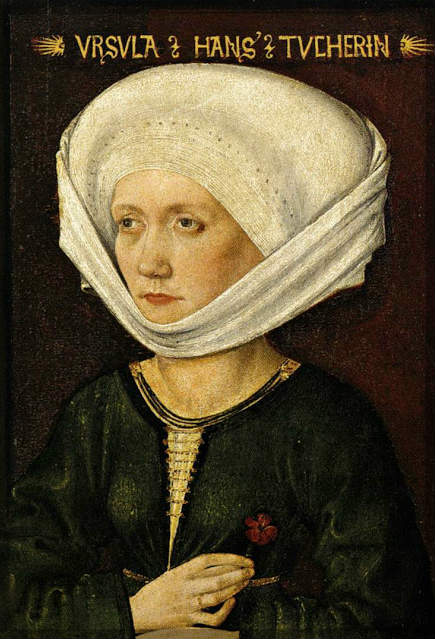Search:: Artists Alphabetically Artists by Country Artists by Century Artists by Movement
Michael
Wolgemut
1434–1519
German Northen Renaissance Painter

Portrait of Ursula Tucher, 1478 by Michael Wolgemut
Michael Wolgemut was born in Nuremberg. He grew up in a creative family of busy painters. His talented father, Valentin Wolgemut, was his first teacher. Wolgemut studied under accomplished painter Hans Pleydenwurff. He became one of the most important Northern Renaissance painter working in Nuremberg in the 16th Century. Like many painters of his time he signed very few paintings. Author Cecil Headlam asserts "Michel Wolgemut’s earliest works show the influence of the Flemish School in full vigour. It was in 1473 that he married the widow of Hans Pleydenwurf, a painter of some reputation, and in his house, beneath the old Castle, proceeded to carry on the firm of Wolgemut and Pleydenwurf. From this workshop all the principal paintings of that period would seem to have issued. It is extremely difficult to determine how far the pictures that have hitherto passed under the name of Michel Wolgemut are really his. The master has certainly failed as a rule to stamp his own personality on his works. This is no doubt due in great part to the fact that he left much of each picture to be done by his pupils and assistants. The “firm” took a frankly business view of their handiwork. The amount of personal attention Michel Wolgemut gave to a picture probably varied with the price paid for it.
Cecil Headlam further states "The female type is at first sight graceful, but on closer acquaintance we find it soulless and unsatisfying. The prominent cheekbones, straight noses, mild expression of almond-shaped eyes, thin lips and lifeless mouths produce an impression very different from that caused by the almost painful intensity of Durer’s portraits. As the fifteenth century draws to a close an increasing severity of design and hardness of expression becomes noticeable. It is not altogether fanciful, I think, to attribute this in part to the stern independent spirit of the Reformation and in part to the prevalence of engraving. For Wolgemut, with Wilhelm Pleydenwurf, paid much attention to woodcarving, and aided doubtless by their youthful apprentice, Albert Durer, illustrated the Schatzbehalter (1491) and the Hartmann-Schedel Chronicle (1493), published by Koberger. The influence of this style of work is perhaps traceable in the flatness and severe modelling of the hands, feet, and faces, and in the stiff movement of the figures in Wolgemut’s pictures."
In Germany, during the time of Wolgemut, Nuremberg was the center of the world in terms of art and architecture. Author Cecil Headlam describes the city "Every house, apart from architectural splendor, was decorated with a painting, whether of some symbol or the patron saint of the family. The very aspect of the streets spoke to the importance of the role which art played in the life of the town. The influence of the town reacted no less surely on the art of the period. Albert Durer, for instance, in spite of his wide experience always speaks in his art, like his master Wolgemut, in the Nuremberg dialect. The intense patriotism and the deep religious feeling which formed so intimate a part of the lives of the citizens are reproduced in their art and literature, giving the greatest examples of them the added charm of locality. Their love of science was no less genuine than their love of art. In June 1471, a few weeks after the birth of Albert Durer, Johannes Muller, the great mathematical genius, “the wonder of his generation,” took up his abode at Nuremberg, making her the true home of physical and mathematical science and contributing mightily to her reputation as “the capital of German art, the most precious jewel of the Empire, the meeting-place of art and industry.” “I have chosen Nuremberg for my place of residence,” he writes, “because there I find without difficulty all the peculiar instruments necessary for astronomy, and there it is easiest for me to keep in touch with the learned of all countries, for Nuremberg, thanks to the perpetual journeyings of her merchants, may be counted the center of Europe.” Inspired with the eager desire to know everything, so characteristic of his age, he was equally desirous to impart his knowledge. We may trace to his influence Durer’s book on geometry and his beautiful chart of the heavens.
Important Words, People, Phrases, Characteristics related to the Northern Renaissance Art Movement - allegorical painting, rebirth, invention of oil painting, Hieronymus Bosch, Limbourg Brothers, Desiderius Erasmus, Robert Campin, Jan Van Eyck, Jean Fouquet, Albrecht Dürer, Johannes Gutenberg, Johann Reuchlin, Martin Luther, rise of the merchant class, Protestant Reformation, Calvinisim, glazing, impasto, scriptorium, illuminator, invention of the printing press, woodcuts, engravings, Antwerp School, Guild of Saint Luke, commerce, Flemish School, Northern Europe, Antwerp School, Flanders, Bruges, renewed interest in classical learning, mythological scenes, genre painting, landscapes, portraits, moralizing overtones, human vices, lust, paradise, spirituality, piousness, living a simple life, reform, Human Reasoning, tradesmen at work, idyllic scenes of peasants, playing games, feasting, linear perspective, \Heliocentric Theory, humour, satire, spiritually significant, illuminated manuscript, idealized biblical themes, scriptorium, emotion, illuminator, iconoclast, Age of Discovery, Virgin and Child, axonometric drawing, curiosity about the natural world, realistic use of colours and light, Old Testament stories, Gospel parables, The Blackdeath, Christian symbolism
☼☼☼☼☼
© HistoryofPainters.com If you like this page and wish to share it, you are welcome to link to it, with our thanks. updated 3/7/2017